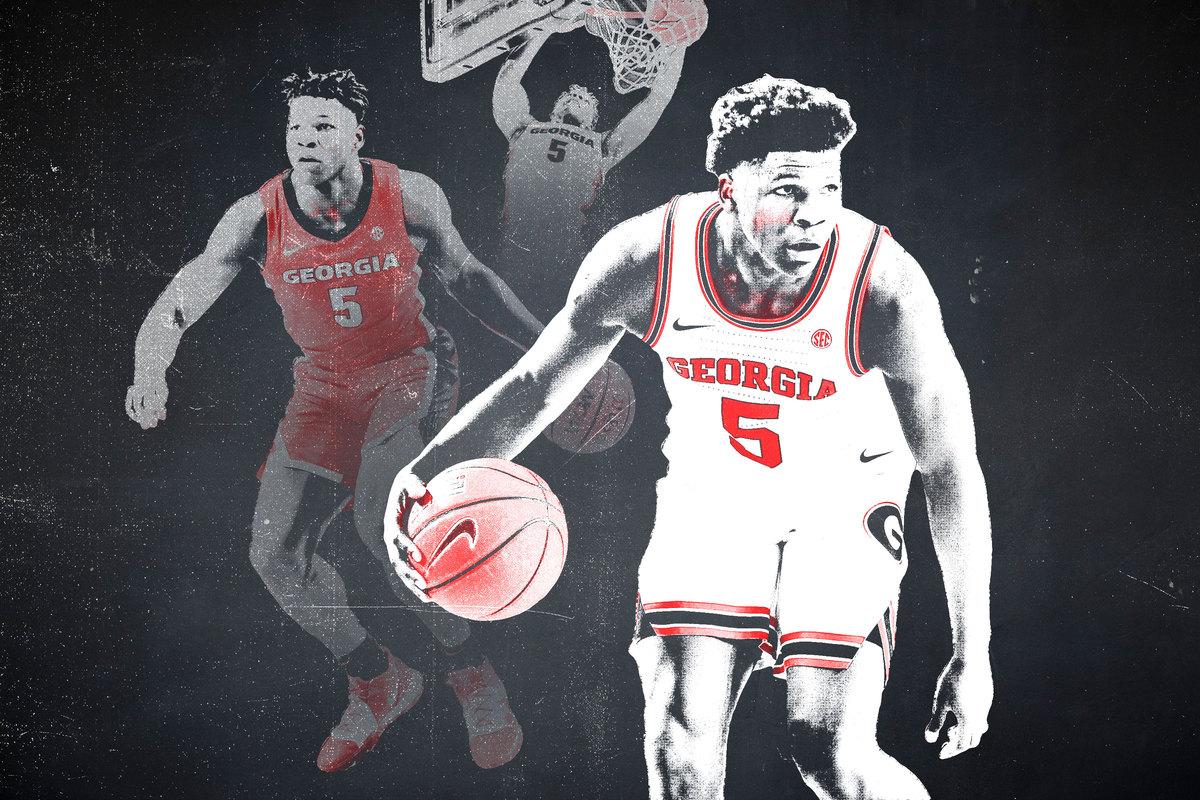
Mississippi State’s new football coach, Mike Leach, had one thought as he watched his school’s basketball team face Georgia a few weeks ago. “There are about 10 players whom I would take on my team without thinking much about it,” he told the ESPN telecast.
It’s no mystery which one would be the best recruit. It’s the same player NBA scouts were in Starkville to see—Georgia freshman Anthony Edwards, one of the front-runners to be the no. 1 pick in this year’s draft.
Edwards is a breathtaking athlete. He’s not built like a basketball player. He looks like a football player who wandered into an open gym and started bullying all the skinnier guys on the court.
His dimensions (6-foot-5 and 225 pounds with a 6-foot-9 wingspan) are closer to a prototypical linebacker than a shooting guard. As Leach likely noticed, Edwards would make for an incredible pass rusher. He has the quickness to get around most offensive linemen before they get out of their stance. And he has the type of broad shoulders that would let him pack even more muscle onto his sturdy frame.
Catch Edwards on the right night and he looks like a superstar. There isn’t much a defense can do when a player with his size and athleticism gets hot from the perimeter. The best example came at the Maui Invitational in November, when Edwards scored 37 points against Michigan State, with 33 coming in a sensational second half:
But there have been just as many nights this season when Edwards has shot his team out of the game. It’s not just that he’s built like a football player—he plays basketball like one, too.
Basketball is a game of decision-making. A player has to make dozens of reads in a single possession—when to attack, when to pass, and who to pass to. Edwards seems to skip that whole process entirely. There are a lot of times when he predetermines what he wants to do regardless of how the defense responds. He’s still learning to differentiate between a shot he can take and a shot he should take. The result is a talented but maddening player who isn’t nearly as effective as he could be.
Edwards has big counting numbers: 19.7 points, 5.5 rebounds, and 1.4 steals per game. But he’s not shooting well (41.1 percent from the field and 31.8 percent from 3-point range) and he’s averaging nearly as many turnovers (2.6) as assists (three).
His inefficiency and poor decision-making impact his team. Georgia is struggling in its second season under head coach Tom Crean. The Bulldogs are on the wrong side of the NCAA tournament bubble with a 12-11 record and a 2-8 mark in SEC play. It’s not all on Edwards. Georgia is a young team with only three upperclassmen in its rotation. But Edwards is part of the problem. He doesn’t make any of his teammates better at this stage of his career.
The plan coming into the season was for Georgia to run its offense through its blue-chip prospect. Edwards started next to two combo guards (seniors Tyree Crump and Donnell Gresham Jr.) whose job was to play off him and space the floor.
It made sense on paper. Edwards puts a lot of pressure on the opposing defense when he has the ball. He’s not a bad passer, despite sometimes making questionable decisions. He has great vision in the open court, when he has more time to figure out what the defense is doing. They can’t build a wall to stop him from getting to the rim, or send multiple defenders without leaving one of his teammates wide open. But when Edwards puts his head down, lowers his shoulder, and tries to power his way through traffic, it doesn’t work as well within the structure of a half-court offense. There are too many possessions that end up looking like this:
Edwards depends on his athleticism and shot-making ability to bail him out of poor decisions. That’s the case even in his best games. Edwards scored 32 points on 10-of-17 shooting in a loss to Florida last week. But the degree of difficulty on some of his shots was insane. It’s almost impossible to make a living playing this way:
Crean was forced to make an adjustment last month. He inserted freshman point guard Sahvir Wheeler into the starting lineup and moved Edwards off the ball. The lineup numbers, courtesy of Pivot Analysis, show how big the difference is when Wheeler is running the show as opposed to Edwards:
Georgia Point Guards
There’s a clear trend line running through everything Edwards does: He’s better when the game is simplified for him. According to the tracking numbers at Synergy Sports, Edwards goes from ranking in the 88th percentile of scorers nationwide in transition to the 45th percentile in the half court. We see the same drop-off with the types of shots he takes. Edwards is in the 56th percentile of players in catch-and-shoot situations and the 30th percentile when launching off the dribble.
His potential is obvious. There are some similarities between Edwards and two other powerfully built shooting guards Crean has coached in college—Dwyane Wade (Marquette) and Victor Oladipo (Indiana). But the two All-Stars were further along than Edwards by the time they reached the NBA. Both spent three years in college.
Wade and Oladipo were more than just great athletes. They were also great passers who could punish the defense for sending double-teams. That ability allowed them to develop into de facto point guards at the NBA level. But it took them a long time to get to that point. There’s no substitute for experience. A player has to run thousands of pick-and-rolls at game speed before he learns how to anticipate what defenses will do. Players have to endlessly cycle through the decision of whether to drive, shoot, or pass until it becomes second nature.
Oladipo wasn’t ready for that much responsibility when he got to the NBA. The Magic drafted him no. 2 in 2013 and tried to turn him into a point guard right out of the gate. But they ended up suffering through all of the growing pains that come with letting a young player learn on the fly without reaping any of the rewards. Oladipo didn’t blossom into an All-Star until landing on his third team and in his fifth NBA season. He was 25 in his first season in Indiana. Edwards is 18. The Georgia star reclassified to skip his junior year of high school and is a full year younger than many other freshmen.
The best-case scenario for Edwards at the next level is finding a team that will bring him along like the Celtics did with Jaylen Brown. Brown, like Edwards, was an elite athlete who struggled to make good decisions in his one season of college basketball. And while Brown was taken with the no. 3 pick in the 2016 draft, he didn’t wind up on a team that needed him to do much. Boston was already a playoff squad. Brown had to earn playing time within a smaller 3-and-D role while slowly growing into a primary option on offense. It was a gradual process. Brown went from averaging 6.6 points per game as a rookie to 20.2 points in his fourth season.
What Edwards and Brown have in common is they can make enough 3s to stay on the floor. The biggest issue for most young wings in the NBA is an inability to fit within a role. They aren’t ready for the responsibility of having the offense run through them, but they also aren’t good enough outside shooters to play off the ball. The defense can sag off them and make it hard for the offense to accomplish anything. Brown was not a great outside shooter when he first came to Boston. But he could at least keep defenses honest. He has never shot lower than 34 percent from 3 in each of his four seasons in the NBA.
Edwards should be able to do that much. There are some encouraging signs when you look beyond his 3-point percentages. The first is the sheer number of 3s (7.5 per game) he’s attempting. Outside shooting is already a huge part of his game. He’s at least prepared to spend most of his time on the perimeter. The second is his free throw percentage (74.6). That’s often the more important number when projecting a player’s shooting ability at the next level because it isolates form and touch from their decision-making. Edwards won’t be starting from the ground up as a shooter. He has a solid foundation to build on. There are no noticeable hitches in his form. The ball looks good coming out of his hands.
But even his 3-and-D ability is still mostly theoretical. Edwards isn’t an elite shooter and he’s an inconsistent defender who often loses track of his man off the ball. He’s not going to make an NBA lineup better in any role. The hope is that he can start off in a smaller role without making things worse. That way a team can afford to develop him while he’s learning the ropes.
Drafting Edwards will be easier for a team that already has a solid offensive structure in place. The most obvious fits in the lottery are those with an elite point guard—Golden State (Steph Curry) and Atlanta (Trae Young). Those types of players attract so much defensive attention that their teammates don’t have to do much beyond knock down open shots.
The concern is what will happen if he winds up on a team that doesn’t have an established playmaker, like Cleveland or New York. Edwards would be one of several young guards fighting for the ball without fully knowing what to do with it. A situation like that could end up reinforcing a lot of his worst habits. There’s no guarantee that Edwards will pan out for the team that drafts him. He has to learn how to operate within a team structure. Andrew Wiggins checked a lot of the same boxes coming out of college. He was an elite athlete with a decent jumper who put up big counting stats in one season at Kansas. Six years in and he’s still the same player. He never made the leap in Minnesota, where he scored a lot of points but wasn’t efficient and didn’t pass the ball. He was just traded to Golden State, which is trying to reverse-engineer his career by putting him into a smaller role.
Edwards could eventually become a star. But he’s not going to save an NBA franchise right away. Possessing all the physical tools in the world doesn’t necessarily mean anything in the pros. His feel for the game still has to catch up to his body.

